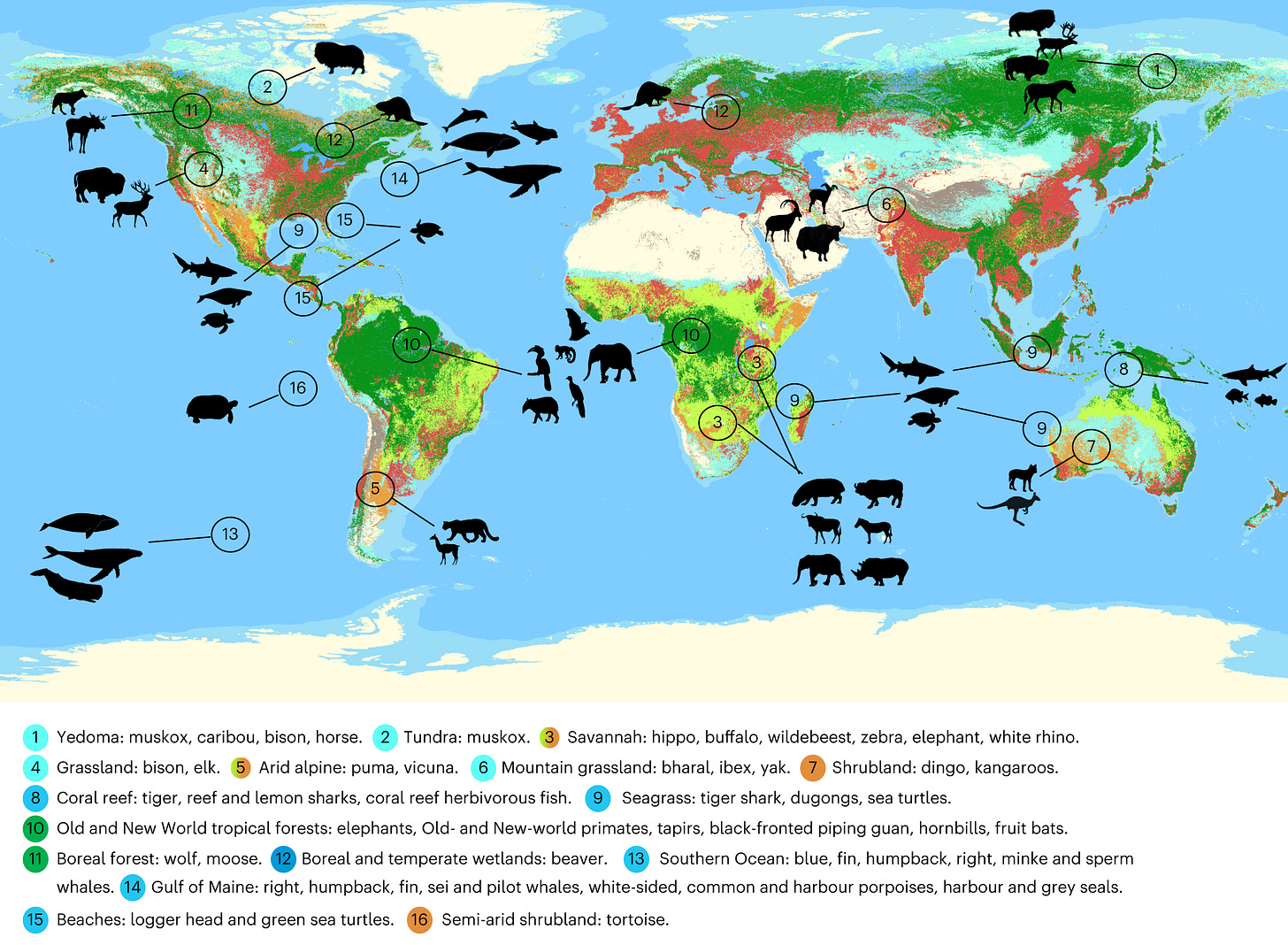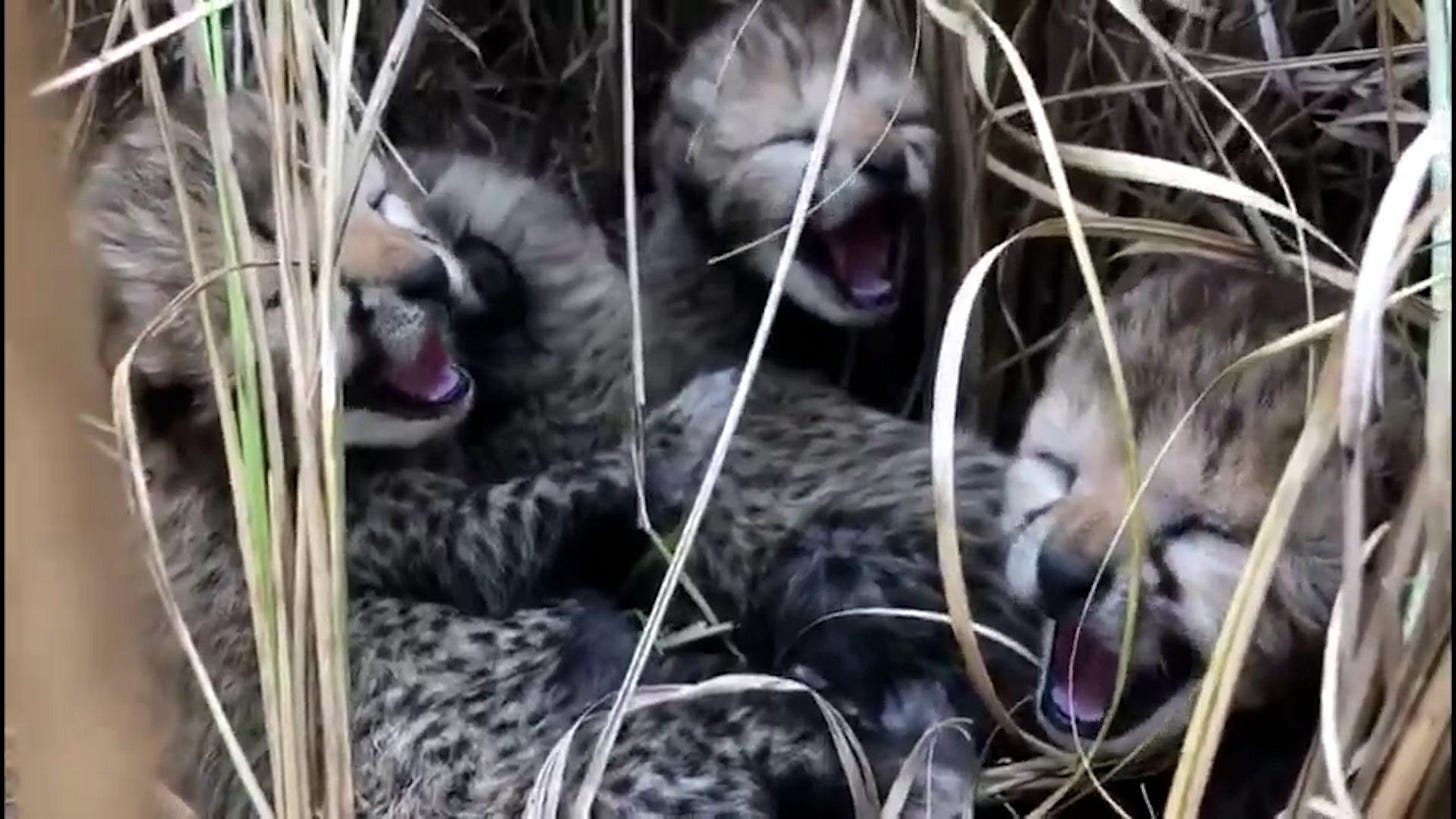The Weekly Anthropocene, April 5 2023
Rewilding to save the climate, an Inflation Reduction Act for Canada, a rooftop solar super-boom in China, cheetah cubs in India, and more!
Rewilding & Climate
A landmark new paper in Nature Climate Change (here’s a free access link, with map), “Trophic rewilding can expand natural climate solutions,” makes the case that restoring large wild animal populations would substantially help in the fight against climate change. Large animals tend to increase landscapes and seascapes’ carbon sequestration capacity in a multitude of ways: encouraging plant growth through mechanisms like seed dispersal, grazing animals preventing wildfires by maintaining a healthy plant density, and a multitude of species fertilizing the land or the sea with their feces to produce more plant life. (Whales and ocean-going fish in particular appear to be responsible for fertilizing vast amounts of carbon-sequestering phytoplankton).
The researchers calculated that if key major animal populations around the world were protected and revived, it would sequester 6.4 billion tons of CO2 per year-about a sixth of global energy sector emissions in 2021. One proven example of this is the Serengeti, which researchers have found now sequesters 4.4 million1 more tons of CO2 per year than when wildebeest populations were at their lowest in the 20th century. Notably for this writer’s home region of New England, the marine mammals of the Gulf of Maine are highlighted as of the 16 hotspots where previous carbon cycle research has found “high potential to expand natural climate solutions through trophic rewilding.” This is a key linkage between the two major environmental issues of climate change and biodiversity conservation, and is a valuable theme to highlight for rewilding and climate projects everywhere!
Clean Energy: North America
The U.S. Energy Information Administration reports (graph) that renewable energy produced more electricity than coal in America in 2022. Coal decreased to 20% of American electricity production in 2022, and the EIA forecasts that it will decrease to 17% in 2023, as wind and solar continue to grow rapidly. Great news!
Prime Minister Justin Trudeau of Canada is proposing a 2023 federal budget for his country with 80 billion Canadian dollars in funding for the renewables revolution (already dubbed a Canadian version of the Inflation Reduction Act!). Highlights include 30% refundable tax credits (i.e. the government pays for 30% of project costs) for investments in solar and wind power, battery storage, and clean manufacturing. With the Liberal and New Democratic parties forming a pro-climate action majority in the Canadian Parliament, this looks very likely to be fully delivered! Here’s a breakdown from a Canadian renewables association, and here’s the official page.
New York’s in-development 132-megawatt South Fork offshore wind farm, which will be the second major commercial offshore wind farm in America after the in-development Vineyard Wind project in Massachusetts, has had its subsea export cable fully installed, linking the project site (56 kilometers east of Montauk Point) to land. Wind turbine installation will begin in summer 2023!
New technologies are arising to support America’s nascent offshore wind industry. Defense tech company Anduril Industries is contracting with the National Offshore Wind Research and Development Consortium to produce an undersea drone, the Dive-LD, to inspect offshore wind transmission lines. Anduril is also working with Saildrone to provide surface ocean drones (i.e. unmanned boats) for ocean and lake mapping. And US Wind and Haizea Wind Group are working to build a harborside steel manufacturing facility. Sparrows Point Steel, in Baltimore, Maryland to make monopile foundations, towers and other offshore wind turbine components.
LG Energy Solutions has announced that they will invest $5.5 billion to build a two-facility battery manufacturing complex in Queen Creek, Arizona, with one facility making EV batteries and the other making lithium iron phosphate batteries for grid-scale and commercial energy storage.
Construction has been completed for the Maduro and Ignacio energy storage facilities, a 200-megawatt grid-scale battery storage complex in South Texas that is now the largest “merchant” (not utility or government owned) energy storage project in the world. It will help stabilize the Texas grid, which has shown itself vulnerable to storms in recent years. This is the first operating project to make use of the new tax credits for grid-scale battery storage created by the Inflation Reduction Act (signed August 2022).
Construction has begun on an 800 MW (0.8 GW) solar project in Illinois. The Double Black Diamond project will provide energy equivalent to that of 85,000 households (much of it to Chicago) and will be both the largest US solar project and the first to use only American-made solar panels!
Manufacturing companies in Mexico, the world’s fourth-largest exporter of auto parts, are increasingly pivoting to making parts for EVs.
Clean Energy: China
Rooftop solar is growing insanely rapidly in China. Bloomberg reports that China added a whopping 51 gigawatts of small-scale (i.e. rooftop) solar capacity in 2022, meaning they installed more rooftop solar alone than any other country installed solar and wind combined! Here’s a non-paywalled version of the full article.
For context, the entire United States had less than 1,200 gigawatts of electricity generating capacity at the end of 2021, and added less than 40 gigawatts of all clean energy, not just rooftop solar, in 2022. And that still counts as really impressive progress in the US, and will likely rise much further in the upcoming years due to the Inflation Reduction Act! China’s rooftop solar boom is just on another level in terms of speed and reach.
Despite the ongoing USA/China geopolitical rivalry and China’s horrific human rights abuses, this counts as good news for democracies too. More Chinese rooftop solar means less air pollution and greenhouse gas emissions, benefiting the entire world!
India
Cheetahs (Acinonyx jubatus) went extinct in India in the 1950s, but a reintroduction program is bringing them back, with eight cheetahs reintroduced from Namibia to Kuno National Park in September 2022. Twelve more from South Africa arrived in February 2023. Now, India has welcomed the first cheetah cubs born in the country in over 70 years, with four healthy cubs born to one of the females from Namibia!
As The Weekly Anthropocene discussed in our in-depth Big Cats article, cheetahs are among the most imperiled of Earth’s majestic felines. Only around 6,500 individuals left, and an illegal cheetah trade driven by Saudi Arabian elites is reducing their numbers still further. As the Indian cheetah population grows,2 a nascent Asian stronghold for the species is ever more valuable!
Note that that’s million, not billion, so a very small slice of the global potential for 6.4 billion tons of CO2 sequestered per year.
One of the other Namibian arrivals has died of kidney failure, so the total Indian cheetah population is now at 23 by this writer’s count.








Nice issue. I love the rewilding concept.